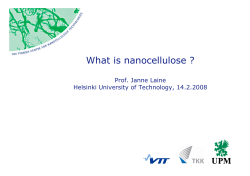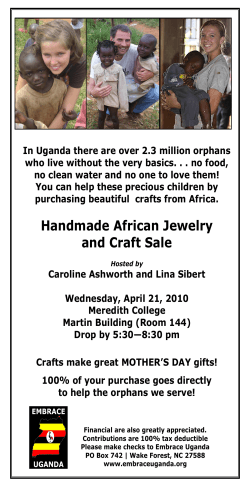
Cellulose- and Chitin- Based Coatings and Films
Cellulose- and Chitin-Based Coatings and Films Carson Meredith Professor Chemical & Biomolecular Engineering Georgia Tech Atlanta, GA 1 One Motivation - Packaging • 1.3 billion tons of food, 1/3 of the world’s production, is spoiled each year before it gets to a consumer’s table. • 2012 food/beverage packaging market $276 billion www.foodproductiondaily.com • 10% is flexible plastic • 27% is rigid plastic • Nearly all of these are petroleum-derived barrier poly(ethylene terephthalate) (PET) plastics poly(vinylidene chloride)) Chem. Soc. Rev. 2011, 40, 5266-5281 Chem. Soc. Rev. 2014, 43, 588-610 2 Motivation 3 Other Motivations • Composites • Light-weight applications in transportation sector • Futuris / American Process / Swinburne / Forest Products Laboratory / Clark Atlanta University Collaboration • Adhesives • Foams and porous materials • Lightweighting • Insulative • Battery electrodes Futuris American Process GaTech CAU Swinburne USDA-FPL 4 Cellulose in wood and plant structures 5 Estimated cellulose nanocrystal Like carbon fiber, potential for highstrength but light-weight 6 Chitin • 2nd most abundant polysaccharide (1010-1011 tons each year) • Structure similar to cellulose • Ability to be functionalized • Biocompatible • Remarkable affinity to proteins • Renewable Kohr E. Chitin: fulfilling a biomaterials promise. Elsevier Science, 2001 7 Chitin Hierarchical architecture in nature Lobster exoskeleton • Lobster exoskeleton: chitin and proteins assemble into hierarchical structures • Exoskeleton consists of chitin nanofibers Acta Materialia 2005, 53: 4281 8 Bio-derived gas barrier materials Key figure is permeability, P Q = vol / time A = area h Δp = pressure change P = DS Qh P= AΔp Units: [cm3 µm m−2 d−1 kPa−1] 1 Barrer = [10−11 cm3 cm cm−2 s−1 mmHg−1] 9 Bio-derived gas barrier materials High aspect-ratio composites used to increase diffusion path length Barrier P difficult to achieve defects at interfaces dispersion of filler Recyclability impacted Chitin and Cellulose nanofibers offer an advantage if used in neat form. 10 Bio-derived gas barrier materials Cellulose nanofibers show promise as barrier films PO2 = 0.17 cc um / m2 d kPa Untreated CNF PO2 = 0.01 cc um / m2 d kPa 175 °C Treated CNF Nair , Zhu, Deng, Ragauskas Sustainable Chemical Processes 2014 Sharma et al., RSC Advances 2014 (Group of Prof. Yulin Deng) 11 Bio-derived gas barrier materials Only a few reports of barrier films involving chitin: • Regenerated chitin films plasticized with glycerol PO2 = 0.003 barrer (35 °C) Journal of Materials Chemistry A 2013, 1 1867 • Composite of chitin nanowhiskers coated on PLA PO2 = 0.001 barrer International Journal of Biological Macromolecules 2012, 50, 69 • No pure chitin films with high barrier properties (prior to our work) 12 Challenges for both cellulose and chitin in applications • Insolubility Organic Solvents Atalla, R. H. and Isogai, A., in Polysaccharides : structural diversity and functional versatility, 2005 13 Challenges for both cellulose and chitin in applications Insolubility • • Approaches to process cellulose / chitin Regeneration: dissolution followed by precipitation • strong acids, bases or volatile organic solvents • disrupts intrinsically high crystallinity Extraction and dispersion of nano-fibers Follow by assembly into film during drying • Acid hydrolysis • Peroxide oxidation (TEMPO) • Grinding result in gelling suspensions • Ultrasonication cannot extract most crystalline α form • High-pressure homogenization Our approach Chitin nanofibers (ChNFs): Wu and Meredith Biomacromolecules 2014, 15, 4614 14 Chitin Nanofiber Generation Crab shell Chitin purification: deproteination and dimineralization Chitin Purified Mechanical chitin/water shearing nanofiber/water dispersion Chitin nanofiber (20 nm) (pH 4)15, 4614 Wu and Meredith Biomacromolecules 2014, Purified chitin (micro-size particles) 0.5 wt.% of chitin Zeta potential curve of chitin nanofiber 15 13C CP-MAS solid state NMR of purified chitin from crab shells Degree of acetylation = 92.4% Wu and Meredith Biomacromolecules 2014, 15, 4614 16 Morphology of Chitin pH 4.1 pH 7.0 Before homogenizer After homogenizer (35 passes) Wu and Meredith Biomacromolecules 2014, 15, 4614 17 Rheological Properties of Dispersions ChNF/water pH of 4.1 35 passes in homogenizer ChNF/water pH of 4.1 4 passes in homogenizer Wu and Meredith Biomacromolecules 2014, 15, 4614 18 Films from Chitin Nanofibers Wu and Meredith Biomacromolecules 2014, 15, 4614 19 Mechanical Properties Chitin nanofiber (ChNF) Film Biomacromolecules 2014, 15, 4614 Cellulose (CNC) Film ACS Appl. Mater. Interfaces 2013, 5, 4640−4647 20 Gas permeabilities in ChNF films Kinetic Permeability diameter (Å) (barrer) H2 2.89 0.024 CO2 3.30 0.018 O2 3.46 0.006 N2 3.64 0.0034 CH4 3.80 0.0027 Gas 0% relative humidity Wu and Meredith Biomacromolecules 2014, 15, 4614 21 ChNF Compared to Other Films PE PP PET ChNF EVOH CNF 0 % RH PO2 (barrer) 0.75-4.73 0.75-1.52, 0.015-0.076 0.006 1.5x10-5 1x10-7 PCO2 (barrer) 11.7-14.6 4 0.3 0.018 Duan et al. Journal of Materials Chemistry A 2013, 1, 1867 Gholizadeh et al. Mater. Des. 2007, 28, 2528 Jarus et al. Polymer 2002, 43, 2401 Tsai et al. Adv. Mater. 2005, 17, 1769 Wu and Meredith Biomacromolecules 2014, 15, 4614 22 Chitin-based porous materials (a) (b) (c) 1 mm 1 µm Can we mimic and improve upon this intricate natural structure? 23 Freeze drying: freezing rate effect • Starting materials: chitin nanofiber (20nm)/water dispersion • Processing approach: Step 1. freeze this dispersion at different conditions: liquid nitrogen, -80 °C, -20 °C, -20 °C (slow) (freezing rate: liquid nitrogen>-80 °C >-20 °C) Step 2. sublimation of ice crystals by freeze drier Pore size: 59.2±7.6 μm • Chitin nanofiber (20nm)/water dispersion: liquid nitrogen freezing (sample bottom touched the liquid nitrogen) Wu and Meredith, ACS Macro Letters, 2014, 3, 185 24 Freeze drying: freezing rate effect Pore size: 59.2±7.6 μm • Chitin nanofiber(20nm)/water dispersion: liquid nitrogen freezing Pore size: 96.2±12.0 μm • Chitin nanofiber(20nm)/water dispersion: -80 OC freezing Wu and Meredith, ACS Macro Letters, 2014, 3, 185 25 Freeze drying: freezing rate effect Pore size: 3.2±0.4 μm • Chitin nanofiber(20nm)/water dispersion: -20 °C Enlarged top SEM image Wu and Meredith, ACS Macro Letters, 2014, 3, 185 26 Composites CNC-Filled Epoxy with Meisha Shofner (MSE) Xu, Girouard, Schueneman, Shofner, Meredith, Polymer, 2013 27 Conclusions – CNFs and ChNFs extracted via chemical/mechanical processes – Formed direct into neat CNF or ChNF films • Low permeability • High transparency • Good mechanical properties. – Developed process for nanoporous chitin foams via freeze drying – Useful for high-strength composites 28 Acknowledgements • GT Renewable Bioproducts Institute • USDA (Greg Schueneman) • Jie Wu, former Ph.D. Student • Natalie Girouard, current Ph.D. Student • Michael Avidano, undergrad researcher • Meisha Shofner, MSE 29
© Copyright 2025









